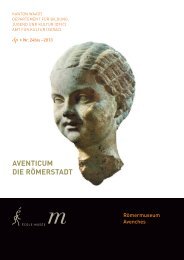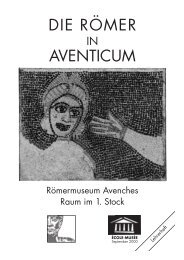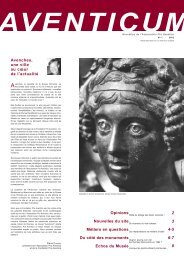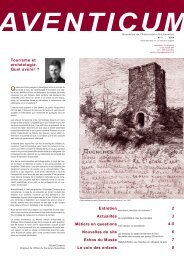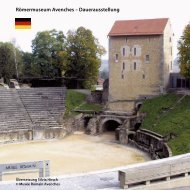Avenches – Roman Museum – Permanent Exhibition
Avenches – Roman Museum – Permanent Exhibition
Avenches – Roman Museum – Permanent Exhibition
Create successful ePaper yourself
Turn your PDF publications into a flip-book with our unique Google optimized e-Paper software.
First Floor Religion<br />
The Local Gods<br />
wet-nurses feeding a child (display case 23, no. 14).<br />
The three-horned bull (display case 23, no. 12) was widely known in Gaul; the<br />
third horn symbolises the power of reproduction.<br />
Sucellus (display case 23, no. 16) whose name means ”he who hits hard“ is<br />
holding a mallet in one hand and a vessel in the other; a dog is at his side. Certain<br />
depictions also show him with a barrel or an amphora. Sucellus was the forest god.<br />
In certain regions he was associated with Silvanus. He also seems to have been the<br />
patron of craftsmen.<br />
Display case 23<br />
1. Inscription dedicated to Anextlomara, Celtic deity (1). The use of the Greek letter X<br />
illustrates the Celtic origin of this name.<br />
Anextlomarae / et<br />
Aug(usto) / Public(ius) Aunus<br />
« To Anextlomara and the emperor. Publicius Aunus (erected this monument) »<br />
Limestone. 1st <strong>–</strong> 3rd centuries AD. Catalogue of inscriptions: no. 25.<br />
2. Limestone head of a genius cucullatus (hooded genius).<br />
3. Bronze bust of a local deity (2). 2nd <strong>–</strong> 3rd centuries AD.<br />
4-5. Iron miniature votive axes (3).<br />
6. Iron miniature votive axe with an engraved X.<br />
7. Bronze miniature votive axe, engraved with Δ.<br />
8. Bronze horse wearing a charm around its neck, probably linked to the goddess Epona.<br />
9. Double-faced terra cotta statuette representing the goddess Epona on her horse (4).<br />
10-11. Female deities linked to Venus. White earthenware statuettes.<br />
12. Three-horned bull in bronze. 1st <strong>–</strong> 2nd centuries AD.<br />
13. Deity of prosperity, linked to the goddess Fortuna. Bronze statuette.<br />
14. Mother goddess. White earthenware statuette.<br />
15. Bull and genius, limestone.<br />
16. Libation scene probably dedicated to the god Sucellus. The upright figure is holding a<br />
bowl; he is wearing a torque, a typical Celtic piece of jewellery around his neck. A second,<br />
kneeling, figure is holding a barrel and a pail closely to his chest. A dog is lying at their<br />
feet. Limestone.<br />
Display case 24<br />
17. Votive deposit consisting of approximately 120 ceramic artefacts (jugs, drinking<br />
cups, stands, lamps) and a limestone altar bearing an inscription dedicated to Mercury<br />
Cissonius.<br />
Deo<br />
Mercur(io) Cisso(nio) L(ucius) C.<br />
Patern(us)<br />
ex voto<br />
« To Mercury Cissonius. Lucius C. Paternus, (erected this monument) after a vow »<br />
Catalogue of inscriptions: no. 26.<br />
1<br />
2<br />
4<br />
3<br />
42<br />
First Floor<br />
23<br />
24



